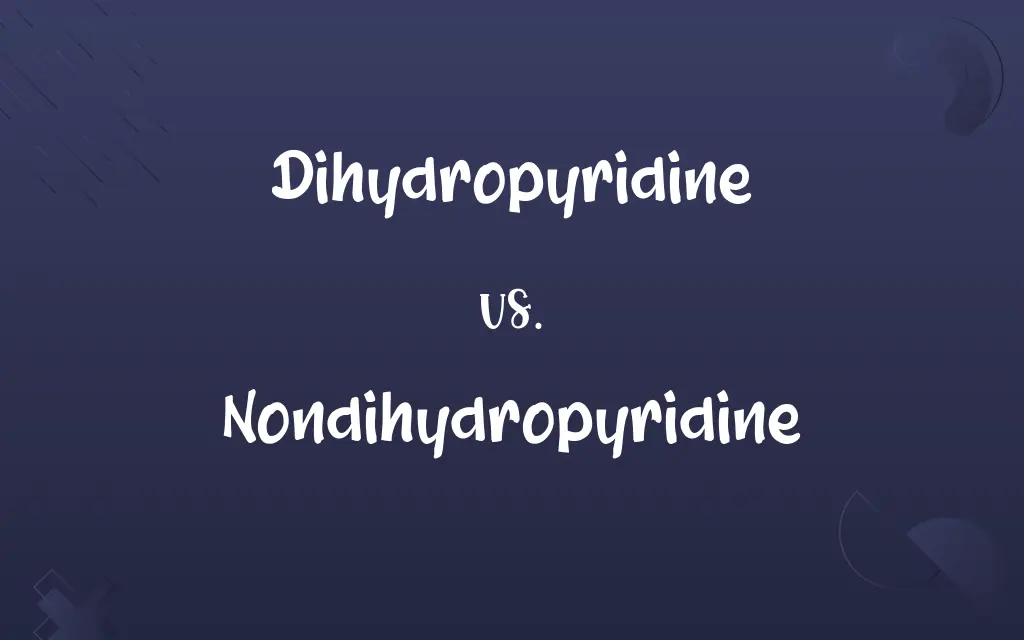Dihydropyridine vs. Nondihydropyridine: Know the Difference

By Shumaila Saeed || Published on January 4, 2024
Dihydropyridines are calcium channel blockers mainly affecting vascular smooth muscle, while nondihydropyridines affect the heart and blood vessels.

Key Differences
Dihydropyridines are a class of medications primarily used to treat hypertension and angina by dilating blood vessels, thus reducing blood pressure. Nondihydropyridines, in contrast, also lower blood pressure but have a more pronounced effect on the heart, reducing heart rate and contractility.
Shumaila Saeed
Jan 04, 2024
Dihydropyridines, such as amlodipine, are known for their selective action on vascular smooth muscles, causing less cardiac depression. Nondihydropyridines, like verapamil, target both the blood vessels and the heart, leading to a decrease in heart rate and a control of heart rhythm.
Shumaila Saeed
Jan 04, 2024
In terms of side effects, dihydropyridines often lead to peripheral edema and flushing due to their vasodilatory effects. Nondihydropyridines, however, can cause bradycardia and may exacerbate conditions like heart failure due to their cardiac effects.
Shumaila Saeed
Jan 04, 2024
The use of dihydropyridines is typically preferred in patients with asthma or chronic obstructive pulmonary disease, as they do not affect lung function. Conversely, nondihydropyridines should be used cautiously in these patients due to potential respiratory side effects.
Shumaila Saeed
Jan 04, 2024
In heart failure treatment, dihydropyridines can be beneficial due to their blood pressure-lowering effects without significantly decreasing cardiac output. Nondihydropyridines are generally avoided in heart failure, especially those with systolic dysfunction, due to their negative inotropic effect.
Shumaila Saeed
Jan 04, 2024
ADVERTISEMENT
Comparison Chart
Side Effects
Peripheral edema, Flushing
Bradycardia, Possible heart failure exacerbation
Shumaila Saeed
Jan 04, 2024
Suitability in Lung Disease
Preferred (No respiratory impact)
Used cautiously (Potential respiratory impact)
Shumaila Saeed
Jan 04, 2024
Use in Heart Failure
Beneficial in some types
Generally avoided, especially in systolic dysfunction
Shumaila Saeed
Jan 04, 2024
ADVERTISEMENT
Dihydropyridine and Nondihydropyridine Definitions
Dihydropyridine
A class of calcium channel blockers used primarily for hypertension.
Amlodipine is a dihydropyridine that helps lower blood pressure.
Shumaila Saeed
Dec 19, 2023
Nondihydropyridine
Medications reducing heart rate and cardiac contractility, along with lowering blood pressure.
The nondihydropyridine was effective in slowing the patient's rapid heartbeat.
Shumaila Saeed
Dec 19, 2023
Dihydropyridine
A type of drug causing vasodilation and reducing systemic vascular resistance.
The patient's leg edema was a side effect of the dihydropyridine therapy.
Shumaila Saeed
Dec 19, 2023
Nondihydropyridine
Calcium channel blockers that can exacerbate heart failure in some cases.
The patient's heart failure symptoms worsened after starting the nondihydropyridine.
Shumaila Saeed
Dec 19, 2023
Dihydropyridine
Drugs with minimal direct cardiac effects, focusing on vascular smooth muscle.
Due to its vascular selectivity, dihydropyridine is preferred in patients with tachycardia.
Shumaila Saeed
Dec 19, 2023
ADVERTISEMENT
Nondihydropyridine
Agents with potential respiratory side effects, used cautiously in lung diseases.
In asthmatic patients, nondihydropyridine use requires careful monitoring.
Shumaila Saeed
Dec 19, 2023
Dihydropyridine
Medications that relax blood vessels, improving blood flow.
Dihydropyridines are effective in treating angina by improving coronary blood flow.
Shumaila Saeed
Dec 19, 2023
Nondihydropyridine
A category of calcium channel blockers affecting both heart and blood vessels.
Verapamil, a nondihydropyridine, is used to control heart rhythm disorders.
Shumaila Saeed
Dec 19, 2023
Dihydropyridine
Agents that are effective in lowering high blood pressure without significant bradycardia.
Doctors often prescribe dihydropyridines for hypertension due to their favorable heart rate profile.
Shumaila Saeed
Dec 19, 2023
Nondihydropyridine
Drugs used in managing hypertension and certain types of angina, affecting cardiac output.
Due to his heart condition, he was prescribed a nondihydropyridine instead of a dihydropyridine.
Shumaila Saeed
Dec 19, 2023
Dihydropyridine
A molecule based upon pyridine, the parent of a class of molecules that have been semi-saturated with two substituents replacing one double bond.
Shumaila Saeed
Dec 13, 2023
Repeatedly Asked Queries
What are dihydropyridines?
Dihydropyridines are calcium channel blockers focusing on vascular smooth muscle relaxation.
Shumaila Saeed
Jan 04, 2024
Can dihydropyridines cause edema?
Yes, peripheral edema is a common side effect.
Shumaila Saeed
Jan 04, 2024
What conditions are treated with dihydropyridines?
Primarily hypertension and angina.
Shumaila Saeed
Jan 04, 2024
Are dihydropyridines safe for patients with lung diseases?
Yes, they do not impact lung function.
Shumaila Saeed
Jan 04, 2024
What are nondihydropyridines?
Nondihydropyridines are calcium channel blockers affecting both the heart and blood vessels.
Shumaila Saeed
Jan 04, 2024
How do nondihydropyridines affect the heart?
They reduce heart rate and affect cardiac rhythm.
Shumaila Saeed
Jan 04, 2024
Are nondihydropyridines used in heart failure?
Generally avoided, especially in systolic dysfunction.
Shumaila Saeed
Jan 04, 2024
Do dihydropyridines affect heart rate?
They have minimal effect on heart rate.
Shumaila Saeed
Jan 04, 2024
Do nondihydropyridines cause bradycardia?
Yes, it's a possible side effect.
Shumaila Saeed
Jan 04, 2024
Can dihydropyridines be used in patients with rapid heartbeats?
They are safe to use as they don't significantly affect heart rate.
Shumaila Saeed
Jan 04, 2024
Can nondihydropyridines be used in asthma patients?
They should be used cautiously due to potential respiratory effects.
Shumaila Saeed
Jan 04, 2024
Are nondihydropyridines suitable for patients with tachycardia?
They can be used to control high heart rate.
Shumaila Saeed
Jan 04, 2024
Are nondihydropyridines used in hypertensive emergencies?
They are generally not the first choice for hypertensive emergencies.
Shumaila Saeed
Jan 04, 2024
Are nondihydropyridines effective for arrhythmias?
Yes, they are used for certain cardiac arrhythmias.
Shumaila Saeed
Jan 04, 2024
Can dihydropyridines cause flushing?
Yes, flushing is a side effect due to vasodilation.
Shumaila Saeed
Jan 04, 2024
Which is preferred for hypertension, dihydropyridine or nondihydropyridine?
Dihydropyridines are commonly preferred for hypertension.
Shumaila Saeed
Jan 04, 2024
Can dihydropyridines be used in angina?
Yes, they are effective in angina management.
Shumaila Saeed
Jan 04, 2024
Do dihydropyridines have a direct effect on cardiac contractility?
They have minimal impact on cardiac contractility.
Shumaila Saeed
Jan 04, 2024
Can nondihydropyridines worsen heart failure symptoms?
Yes, especially in cases of systolic dysfunction.
Shumaila Saeed
Jan 04, 2024
Is edema a side effect of nondihydropyridines?
It's less common compared to dihydropyridines.
Shumaila Saeed
Jan 04, 2024
Share this page
Link for your blog / website
HTML
Link to share via messenger
About Author
Written by
Shumaila SaeedShumaila Saeed, an expert content creator with 6 years of experience, specializes in distilling complex topics into easily digestible comparisons, shining a light on the nuances that both inform and educate readers with clarity and accuracy.









































































